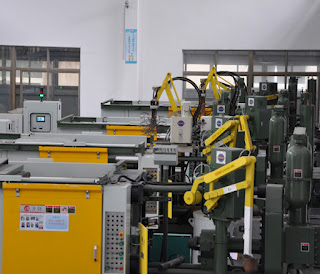This article depicts about the dedication to the developments and alterations in the industry of aluminum high pressure diecasting. This chapter deals with new technologies, as one of the four challenges, and productivity improvements.
Technological developments are absolutely required because of the serious changes in the area of the product portfolio, as well as the increased pressure of cost optimization.
The
requirements that define this for the foundries are huge. The situation gives
no room to move with respect to time. Simultaneously at short notice, new products
must be designed and industrialized, as well as new processes developed or at
least further developed.
High
demand for foundry in the short term, expertise, and financial resources is
required. It is needed in the medium term. This can result in the following
relevant short-term fields of action:
- Heat treatment
- Vacuum die casting
- Minimal lubrication
- Salt cores
- Alloy development
The additive manufacturing process (currently only interesting for prototype
development)
Technology
roadmaps have to be created and prioritized depending on the long-term
corporate strategy and the individual know-how level of the foundries.
You
can save time, money, and resources by having partnerships with customers,
suppliers, universities as well as market companions, and make the necessary difference at the end of the day.This the article depicts the dedication to the developments and alterations in the
industry of aluminum high pressure die
casting. This chapter deals with new technologies, as one of the four
challenges, and productivity improvements.
Technological
developments are absolutely required because of the serious changes in the area
of the product portfolio, as well as the increased pressure of cost
optimization.
The
requirements that define this for the foundries are huge. The situation gives
no room to move with respect to time. Simultaneously at short notice, new products
must be designed and industrialized, as well as new processes developed or at
least further developed.
High
demand for foundry in the short term, expertise, and financial resources is
required. It is needed in the medium term. This can result in the following
relevant short-term fields of action:
- Heat treatment
- Vacuum die casting
- Minimal lubrication
- Salt cores
- Alloy development
The
additive manufacturing process (currently only interesting for prototype
development)
Technology
roadmaps have to be created and prioritized depending on the long-term
corporate strategy and the individual know-how level of the foundries.
You
can save time, money, and resources by having partnerships with customers,
suppliers, universities as well as market companions, and make the necessary
difference at the end of the day.
In
the aluminum high pressure die casting
process, porosity causes costly scrap loss and in critical high-strength
applications, it limits the use of die-cast parts. To the die casting process
parameters, the amount of porosity is closely related. Consequently, in
relation to die casting parameters the mechanisms of porosity formation needs
to be studied in detail. The requirements that define this for the foundries
are huge.
Salt Core Technology
For
a long time, salt core technology has been around. However, the right
breakthrough has so far failed. A promising future application was the
closed-deck cylinder crankcases were considered for a long time. However, for
this application e-mobility, there will be a limitation in the cost
development.
In
the aluminum high pressure die casting
process, porosity causes costly scrap loss and in critical high-strength
applications, it limits the use of die-cast parts. To the die casting process
parameters, the amount of porosity is closely related. Consequently, in
relation to die casting parameters the mechanisms of porosity formation needs
to be studied in detail. The requirements that define this for the foundries
are huge.
Salt Core Technology
For a long time, salt core technology has been around. However, the right
breakthrough has so far failed. A promising future application was the
closed-deck cylinder crankcases were considered for a long time. However, for
this application e-mobility, there will be a limitation in the cost
development.
However, for these parts, current technology advancement is unlikely due to other key issues and also because of aluminum high pressure die casting machines. Follow us on Facebook







